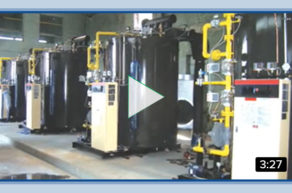How Are Boilers Used On University Campuses?
The boiler system on a university campus often goes unnoticed, but the truth is that it plays a vital role in keeping the university operating. In fact, without that system in place, the university wouldn’t be able to function. That’s why it’s critical to choose a university campus boiler carefully.
With that in mind, it seems pertinent to take a closer look at how boilers are used on college campuses and what they contribute to campus operations.
Heat and Hot Water
The biggest job of boilers on a college campus is to provide heat and hot water for the entire campus. Steam plants at these institutions are usually connected both to the hot water supply and the heating systems campus-wide. Sometimes the boilers need to produce hundreds of thousands of pounds of steam every hour. Keep in mind that even small campuses have dozens of buildings, all of which need heat and hot water over the course of the day.
Mornings are usually the busiest time of day for university boiler systems. This tends to be the coldest part of the day, and every building on campus needs to be heated to an appropriate temperature. This is also the time of day when students living in on-campus dorms are taking showers and getting ready for the day, requiring large amounts of hot water at the same time buildings need heat.
The demand for steam tends to drop in the afternoon and evening once most buildings have been able to heat up. However, universities in cold-weather climates tend to need a steady supply of steam to make sure campus buildings can maintain a comfortable temperature.
Food Preparation
College cafeterias must prepare thousands of meals every day, sometimes three times a day. These facilities also rely on the boiler room to provide hot water and steam, both to prepare food and to clean and sterilize utensils and dishes. The campus may also include snack bars at student hangouts, which also need hot water and steam. Thus, the demand for steam on campus tends to increase during meal times.
Laundry
While students generally do their own laundry, many college campuses provide washing machines that need a constant supply of hot water. Additionally, the school may have their own laundering needs for special banquet events and/or providing towels at the gym, and they may have professional-level laundering facilities to accommodate university laundry needs. The boiler room will also supply steam and hot water to clean and sterilize campus laundry.
How to Choose a Steam Boiler for Your University Campus
With so many uses for steam to consider, colleges and universities need a boiler system that is heavy-duty, reliable, and hopefully energy efficient. Let’s look at some factors to consider.
Quick Startup
The boiler system on college campuses can’t be slow at getting started. With conventional firetube boilers, it’s sometimes difficult to reach full capacity in a short period of time, and in fact, they may take hours to produce steam once they are fired up. Schools often experience fluctuations in demand during the course of the day, and if the boiler system takes too long to heat up, the school has to keep it running even during periods of low demand — all at additional cost. As an alternative, universities might consider high-efficiency watertube boilers, which can reach full steam in minutes rather than hours. Quicker startup times mean schools can afford to power down their boiler systems when the demand for steam decreases.
Cutting Fuel Costs
Obviously, producing steam for a university campus can be a costly endeavor, so the more fuel-efficient a boiler system is, the better it is for the school. Conventional boilers require large amounts of natural gas or fuel oil to operate, not to mention the slow startup times require the boilers to stay running idle when not in use. Alternately, smaller, modular watertube boilers require far less fuel without sacrificing BTU output, and they can be easily powered down when steam isn’t needed. Most campuses experience at least a 20 percent reduction in energy costs in this manner.
Backup System for Seamless Operations
If your campus relies on one or two large fire tube boilers, you could be in trouble if one of those boilers breaks down or needs to go offline during routine maintenance. Even if it’s summertime and there are fewer people on campus, it’s difficult to go without steam for an extended period of time. Rather than take this risk, many universities are choosing to replace large conventional boilers with a series of smaller modular watertube boilers. This type of configuration ensures that steam heat is always available, even if one or two modules go down for servicing. In addition, modular boilers also save money because they can fire up and power down as needed to meet fluctuating demands.
Small Environmental Footprint
More so than other businesses and organizations, university campuses should be aware of their carbon footprint. While conventional boilers tend to put out high greenhouse gas emissions, some new boiler solutions have been designed in a way that reduces the amount of greenhouse gases, NOx emissions, and other harmful substances. A simple switch to modern boilers can drastically reduce their environmental impact, even for campuses that aren’t legally required to be more stringent with their emissions.
The Best University Boiler
Many universities have found that the ideal boiler for their campus is one produced by Miura. With a series of Miura’s modular, water tube boilers, university campuses will be able to meet their fluctuating steam needs, including the high demand at peak hours. Miura boilers will also help to reduce fuel costs compared to traditional boilers, and they are rated for low NOx emissions to reduce the carbon footprint. In short, Miura makes the perfect boiler for any university campus, large or small. Locate a Miura rep to learn more.







